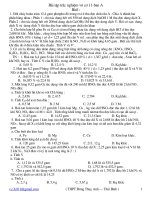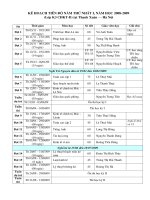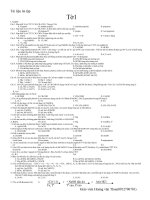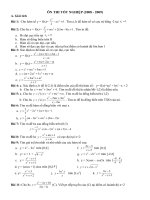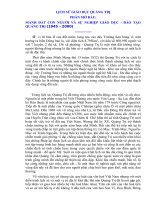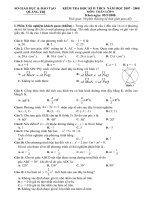ch11pr btap ktoan qtri
Bạn đang xem bản rút gọn của tài liệu. Xem và tải ngay bản đầy đủ của tài liệu tại đây (334.95 KB, 3 trang )
Problems: Set C
o l l e g e/ w
/c
www
.
Problems: Set C
g a n dt
wi
ey
ley.co m
P11-1C Loi Corporation manufactures a single product. The standard cost per unit of
product is as follows.
Direct materials—2 pounds of plastic at $5 per pound
Direct labor—2 hours at $12 per hour
Variable manufacturing overhead
Fixed manufacturing overhead
$10
24
8
6
Total standard cost per unit
$48
Compute variances.
(SO 4, 5)
The master manufacturing overhead budget for the month based on normal productive
capacity of 20,000 direct labor hours (10,000 units) shows total variable costs of $80,000
($4 per labor hour) and total fixed costs of $60,000 ($3 per labor hour). Normal productive capacity is 20,000 direct labor hours. Overhead is applied on the basis of direct
labor hours. Actual costs for November in producing 9,800 units were as follows.
Direct materials (20,500 pounds)
Direct labor (19,600 hours)
Variable overhead
Fixed overhead
Total manufacturing costs
$100,450
239,120
78,100
59,200
$476,870
The purchasing department normally buys the quantities of raw materials that are expected to be used in production each month. Raw materials inventories, therefore, can
be ignored.
Instructions
(a) Compute all of the materials and labor variances.
(b) Compute the total overhead variance.
P11-2C Malik Manufacturing Company uses a standard cost accounting system to account for the manufacture of exhaust fans. In July 2011, it accumulates the following
data relative to 1,800 units started and finished.
Cost and Production Data
Raw materials
Units purchased
Units used
Unit cost
Direct labor
Hours worked
Hourly rate
Manufacturing overhead
Incurred
Applied
Actual
Standard
21,000
21,000
$3.30
22,000
$3.00
3,450
$11.80
3,600
$12.50
Compute variances, and
prepare income statement.
(SO 4, 5, 7)
$101,500
$108,000
Manufacturing overhead was applied on the basis of direct labor hours. Normal capacity for the month was 3,400 direct labor hours. At normal capacity, budgeted overhead
costs were $20 per labor hour variable and $9 per labor hour fixed. Total budgeted fixed
overhead costs were $30,600.
Jobs finished during the month were sold for $280,000. Selling and administrative
expenses were $25,000.
Instructions
(a) Compute all of the variances for (1) direct materials and (2) direct labor.
(b) Compute the total overhead variance.
(c) Prepare an income statement for management. Ignore income taxes.
P11-3C Tran Clothiers manufactures women’s business suits. The company uses a
standard cost accounting system. In March 2011, 15,700 suits were made. The following
standard and actual cost data applied to the month of March when normal capacity was
20,000 direct labor hours. All materials purchased were used in production.
Compute and identify
significant variances.
(SO 4, 5, 6)
1
2
chapter 11 Standard Costs and Balanced Scorecard
Cost Element
Standard (per unit)
Direct materials
5 yards at $6.90 per yard
Direct labor
1.0 hours at $11.40 per hour
Overhead
1.0 hours at $9.30 per hour
(fixed $6.30; variable $3.00)
Actual
$547,200 for 76,000 yards
($7.20 per yard)
$166,880 for 14,900 hours
($11.20 per hour)
$120,000 fixed overhead
$45,000 variable overhead
Overhead is applied on the basis of direct labor hours. At normal capacity, budgeted fixed
overhead costs were $126,000, and budgeted variable overhead costs were $60,000.
Instructions
(a) Compute the total, price, and quantity variances for (1) materials and (2) labor.
(b) Compute the total overhead variance.
(c)
Which of the materials and labor variances should be investigated if management considers a variance of more than 5% from standard to be significant?
Answer questions about
variances.
(SO 4, 5)
P11-4C Bota Manufacturing Company uses a standard cost accounting system. In 2011,
50,000 units were produced. Each unit took several pounds of direct materials and 2 standard hours of direct labor at a standard hourly rate of $12.00. Normal capacity was 96,000
direct labor hours. During the year, 200,000 pounds of raw materials were purchased at
$1.00 per pound. All materials purchased were used during the year.
Instructions
(a) If the materials price variance was $10,000 unfavorable, what was the standard
materials price per pound?
(b) If the materials quantity variance was $23,750 favorable, what was the standard
materials quantity per unit?
(c) What were the standard hours allowed for the units produced?
(d) If the labor quantity variance was $10,920 unfavorable, what were the actual direct
labor hours worked?
(e) If the labor price variance was $30,273 favorable, what was the actual rate per hour?
(f) If total budgeted manufacturing overhead was $796,800 at normal capacity, what was
the predetermined overhead rate per direct labor hour?
(g) What was the standard cost per unit of product?
(h) How much overhead was applied to production during the year?
(i) Using selected answers above, what were the total costs assigned to work in process?
Compute variances, prepare
an income statement, and
explain unfavorable
variances.
P11-5C Alon Labs performs steroid testing services to high schools, colleges, and universities. Because the company deals solely with educational institutions, the price of
each test is strictly regulated. Therefore, the costs incurred must be carefully monitored
and controlled. Shown below are the standard costs for a typical test.
(SO 4, 5, 7)
Direct materials (1 petrie dish @ $2 per dish)
Direct labor (0.5 hours @ $20 per hour)
Variable overhead (0.5 hours @ $8 per hour)
Fixed overhead (0.5 hours @ $4 per hour)
Total standard cost per test
$ 2.00
10.00
4.00
2.00
$18.00
The lab does not maintain an inventory of petrie dishes. Therefore, the dishes purchased each month are used that month. Actual activity for the month of May 2011, when
2,500 tests were conducted, resulted in the following.
Direct materials (2,540 dishes)
Direct labor (1,240 hours)
Variable overhead
Fixed overhead
$ 5,207
26,164
10,100
5,900
Monthly budgeted fixed overhead is $6,000. Revenues for the month were $58,000,
and selling and administrative expenses were $2,500.
Problems: Set C
3
Instructions
(a) Compute the price and quantity variances for direct materials and direct labor.
(b) Compute the total overhead variance.
(c) Prepare an income statement for management.
(d) Provide possible explanations for each unfavorable variance.
*P11-6C Pham Manufacturing Company uses standard costs with its job order cost
accounting system. In January, an order (Job No. 84) was received for 5,500 units of
Product D. The standard cost of 1 unit of Product D is as follows.
Direct materials—1.4 pounds at $4.00 per pound
Direct labor—1 hour at $9.00 per hour
Overhead—1 hour (variable $7.40; fixed $8.00)
$ 5.60
9.00
15.40
Standard cost per unit
$30.00
Journalize and post standard
cost entries, and prepare
income statement.
(SO 4, 5, 7, 9)
Overhead is applied on the basis of direct labor hours. Normal capacity for the month
of January was 6,000 direct labor hours. During January, the following transactions applicable to Job No. 84 occurred.
1.
2.
3.
4.
5.
6.
7.
8.
9.
Purchased 8,200 pounds of raw materials on account at $3.60 per pound.
Requisitioned 8,200 pounds of raw materials for production.
Incurred 5,200 hours of direct labor at $9.25 per hour.
Worked 5,200 hours of direct labor on Job No. 84.
Incurred $85,760 of manufacturing overhead on account.
Applied overhead to Job No. 84 on the basis of direct labor hours.
Transferred Job No. 84 to finished goods.
Billed customer for Job No. 84 at a selling price of $280,000.
Incurred selling and administrative expenses on account $65,000.
Instructions
(a) Journalize the transactions.
(b) Post to the job order cost accounts.
(c) Prepare the entry to recognize the total overhead variance.
(d) Prepare the January 2011 income statement for management.
*P11-7C Using the information in P11-1C, compute the overhead controllable variance and
the overhead volume variance.
Compute overhead controllable
and volume variances.
(SO 10)
*P11-8C Using the information in P11-2C, compute the overhead controllable variance
and the overhead volume variance.
Compute overhead controllable
and volume variances.
(SO 10)
*P11-9C Using the information in P11-3C, compute the overhead controllable variance
and the overhead volume variance.
Compute overhead controllable
and volume variances.
(SO 10)
*P11-10C Using the information in P11-5C, compute the overhead controllable variance
and the overhead volume variance.
Compute overhead controllable
and volume variances.
(SO 10)
